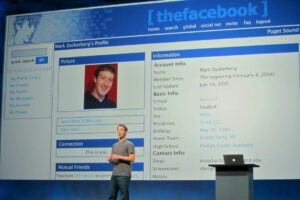When last week Meta Platforms, Inc. CEO Mark Zuckerberg shared a photograph of his Facebook page from 20 years ago — back when it was “thefacebook” — it was, for me, a little like the sponge cake that cast Proust back in time. The bare-bones profile page felt achingly familiar because I was one of thefacebook’s first few dozen users.
In those first weeks, with just 1,000 or so Harvard students registered, the website that would become Facebook was spartan in design and limited in what it promised. It hadn’t yet added all the compelling bells-and-whistles that have transformed the platform into the election-warping, government-shaking, memory-making behemoth it is today. In retrospect, though, some of its fatal flaws should perhaps have been obvious from the start.
Us early Facebookers used the site for three things. First, and most important, we could choose our own profile picture. This was vital, as our photos in the official school directory were often taken during our first days on campus, mostly with regrettable hometown haircuts. It also meant that the performative aspect of Facebook was its most distinctive feature from the get-go.
Second, we could create various groups of dubious utility (“people who think Harvard Square needs a greasy spoon diner”). While only half-serious, these communities helped us figure out what shared identities caught on and could become popular.
Finally, we could check up on who knew whom, and whether either of them was single. In the pre-smartphone era, getting such information when you needed it wasn’t easy. Some students I knew left parties midway to run to the computer lab, log on, check up on all the guests, and return armed with crucial intelligence.
What we never had to question was whether the other people on thefacebook.com were who they said they were, or whether they were telling the truth. We took that part for granted.
That’s because of where we were: Facebook was designed for people who already owed something to each other, simply by being part of the same campus community. The university was the real social network; Facebook was just a website that helped you navigate it. It was an addition to real life, not a replacement for it.
Regardless of its vast size and unparalleled reach, today’s 20-year-old Facebook seems as unprepared for the real world as us early adopters were when we were in our late teens and early 20s. In the real world, people do not have the mutual responsibilities that are taken for granted on a college campus. A university-centric model of networking isn’t designed for people who lie about who they are and what they want. Such users can create entirely false personas and narratives, and those can slowly take over the site.
Zuckerberg recognized the threat fairly early on; he famously insisted in 2010 that people have “one identity,” and that showing more than one face to the world was “an example of a lack of integrity.” But the 14 years since have proven that web-based social networks can’t impose integrity on their users. Only social networks in the real world can.
The links between Facebook and the real world were finally severed when what was once a “mini-feed,” showing you what the people you knew were doing, turned into a real “news feed,” in which over time you could share with people the news stories you were reading. This intersected neatly with the performative and identity-forming bits of Facebook’s DNA.
It also made the company and Zuckerberg himself a lot of money. Unfortunately, it was also deeply dangerous. It transformed the site into something more addictive but less functional, and much less grounded in real relationships. Early Facebook groups were designed to be, at worst, mean about professors. Now, in already divided societies such as India, they often spread religious and ethnic hatred, with harsh consequences.
One can only wonder what the world would have been like if another social network, one which did not assume mutual trust and responsibility from the start, had sprung up instead of Facebook. Another recent post from Zuckerberg — this time on Instagram — featured a clip from a very early interview where he pointed out, “When we first launched, we were hoping for 400, maybe 500 people; now we’re at 100,000 people, so who knows where we’re going next.” As one of those 400, maybe 500 people, I can’t say I am eager to find out.
BLOOMBERG OPINION
